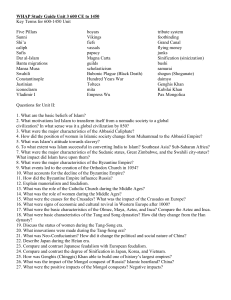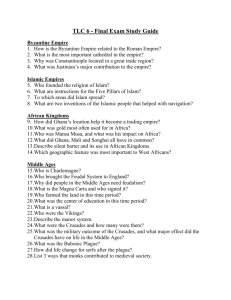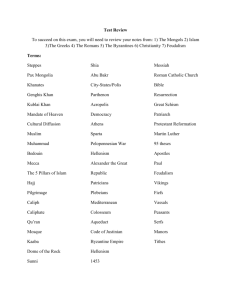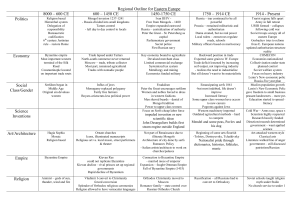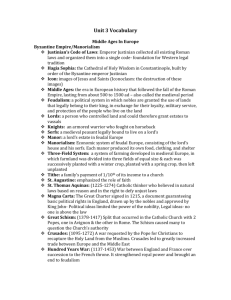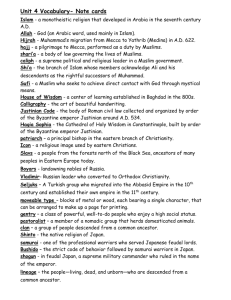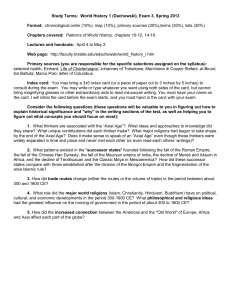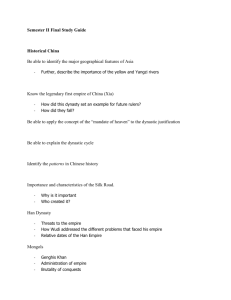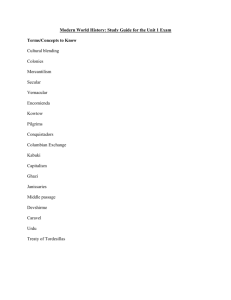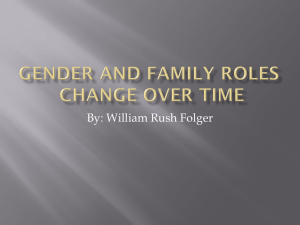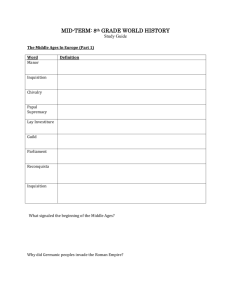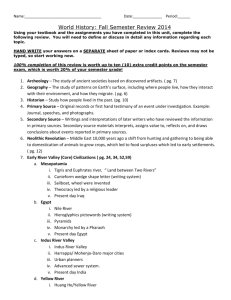AP World History 2 HW Sheet Hackney 2013
advertisement
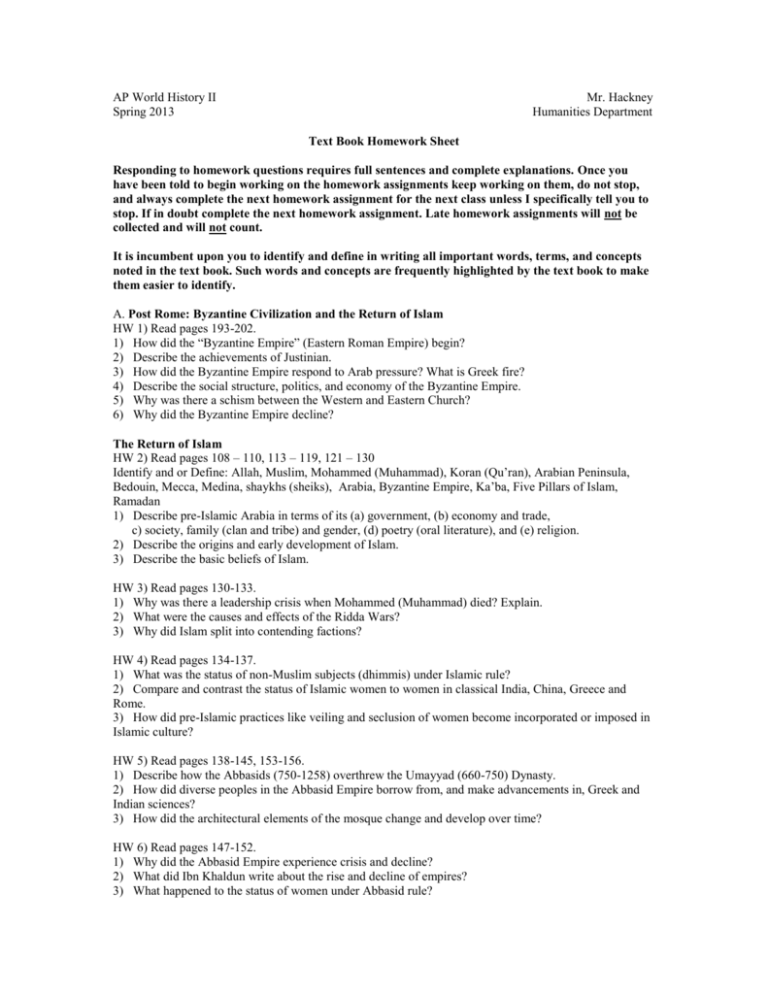
AP World History II Spring 2013 Mr. Hackney Humanities Department Text Book Homework Sheet Responding to homework questions requires full sentences and complete explanations. Once you have been told to begin working on the homework assignments keep working on them, do not stop, and always complete the next homework assignment for the next class unless I specifically tell you to stop. If in doubt complete the next homework assignment. Late homework assignments will not be collected and will not count. It is incumbent upon you to identify and define in writing all important words, terms, and concepts noted in the text book. Such words and concepts are frequently highlighted by the text book to make them easier to identify. A. Post Rome: Byzantine Civilization and the Return of Islam HW 1) Read pages 193-202. 1) How did the “Byzantine Empire” (Eastern Roman Empire) begin? 2) Describe the achievements of Justinian. 3) How did the Byzantine Empire respond to Arab pressure? What is Greek fire? 4) Describe the social structure, politics, and economy of the Byzantine Empire. 5) Why was there a schism between the Western and Eastern Church? 6) Why did the Byzantine Empire decline? The Return of Islam HW 2) Read pages 108 – 110, 113 – 119, 121 – 130 Identify and or Define: Allah, Muslim, Mohammed (Muhammad), Koran (Qu’ran), Arabian Peninsula, Bedouin, Mecca, Medina, shaykhs (sheiks), Arabia, Byzantine Empire, Ka’ba, Five Pillars of Islam, Ramadan 1) Describe pre-Islamic Arabia in terms of its (a) government, (b) economy and trade, c) society, family (clan and tribe) and gender, (d) poetry (oral literature), and (e) religion. 2) Describe the origins and early development of Islam. 3) Describe the basic beliefs of Islam. HW 3) Read pages 130-133. 1) Why was there a leadership crisis when Mohammed (Muhammad) died? Explain. 2) What were the causes and effects of the Ridda Wars? 3) Why did Islam split into contending factions? HW 4) Read pages 134-137. 1) What was the status of non-Muslim subjects (dhimmis) under Islamic rule? 2) Compare and contrast the status of Islamic women to women in classical India, China, Greece and Rome. 3) How did pre-Islamic practices like veiling and seclusion of women become incorporated or imposed in Islamic culture? HW 5) Read pages 138-145, 153-156. 1) Describe how the Abbasids (750-1258) overthrew the Umayyad (660-750) Dynasty. 2) How did diverse peoples in the Abbasid Empire borrow from, and make advancements in, Greek and Indian sciences? 3) How did the architectural elements of the mosque change and develop over time? HW 6) Read pages 147-152. 1) Why did the Abbasid Empire experience crisis and decline? 2) What did Ibn Khaldun write about the rise and decline of empires? 3) What happened to the status of women under Abbasid rule? HW 7) Read pages 158-168. 1) Compare and contrast the spread of Islam between South and Southeast Asia. HW 8) Read pages 203-210. 1) How did Christianity spread into Central/Eastern Europe? Describe the effects of Western and Eastern Christianity on the development of Poland, Hungary, Lithuania and Slavic lands. 2) Why did Judaism develop a distinctive culture in Eastern Europe? 3) Describe the events that led to the Russian conversion to Christianity. 4) How was Byzantium used as a model for culture in the 11th century? 5) Why did Kievan Rus' decline? B. Medieval Europe HW 9) Read pages 213-220. 1) How did Charlemagne try to reorganize Western Europe after the “Dark Ages” (Early Middle Ages)? 2) Describe the system of exchange known as feudalism. 3) How did “manorialism” work? Describe the changes made in agriculture under the manor system. HW 10) Read pages 220-224. 1) How did the investiture controversy demonstrate the Church-State relationship during the Middle Ages? How did this relationship change over time? HW 11) Read pages 224-232. 1) Compare and contrast the Early Middle Ages (476-1000) with the High Middle Ages (1000-1300). Write about 2 changes that have occurred as well as 2 continuities. Topics include: the Church, education, art and architecture, literature, the rise of towns, trade, and the status of women. HW 6) Read pages 232-236. 1) Why did medieval institutions begin to decline after 1300? C. East Asia including Feudal Japan HW 12) Read pages 263-270. 1) How did rebuilding the Confucian bureaucracy help the T'ang Dynasty? 2) Describe the religious struggles between Confucianism, Daoism, and Buddhism under the T'ang Dynasty. HW 13) Read pages 299-302. 1) How did Korea combine native traditions and Chinese influence to create a distinctive culture? 2) Compare and contrast the “Sinofication” of Korea under the Silla dynasty and the Koryo dynasty. 3) Describe the social structure of Korea, with emphasis on the elite/aristocratic class. HW 14) Read pages 287-293. 1) Why did Chinese civilization spread to Japan, Vietnam and Korea? 2) Describe the major developments of Japanese government and culture during the (a) Taika, (b) Nara, and (c) Heian periods. 3) Why did Japanese imperial power decline? 4) Describe the structure of samurai rule. What was the basis of their power? HW 15) Read pages 294-298. 1) Describe the emergence and development of the Shogunate in Japan from the 14th century to the 16th century 2) Compare and contrast the characteristics of Japanese with that of European feudalism. 3) What were the sources of inspiration for Japanese art in the feudal period? HW 16) Read pages 302-309. 1) Compare and contrast Vietnamese government, economy and culture before and after Han Chinese conquest and “Sinofication.” 2) How did the status of Vietnamese women differ from that of Chinese women? Cite in particular the example of the Trung sisters, and Vietnamese attitudes towards Chinese polygamy. 3) How did Vietnam gain their independence and expand southward? 4) Describe the social and political divisions that developed in Vietnam. D. Nomadic Empires: Vikings, Mongols, & Turks HW 17) Read pages 214-215, 219, 221, & 361 1) Who were the Vikings and how did they have an impact on the world? HW 18) Read pages 313-320. 1) How did Genghis Khan become a great warrior and expand his empire? 2) What was life like under the Mongol Empire? HW 19) Read pages 320-325. 1) How did the Mongols conquer such a vast amount of territory and move further west? HW 20) Read pages 325-333. 1) How did the Mongols administer the conquered area of China? 2) How did Mongol gender roles influence the Mongol rule of China? Cite in particular the influence of Chabi, Kublai Khan's wife. 3) Describe Marco Polo's contributions in the East and the West E. Crusades HW 21) Review pages 221-222. 1) Explain the main causes and effects of the Crusades. F. West African Kingdoms HW 22) Read pages 171-173. 1) Describe some elements that provided a basis for unity across Africa. 2) What factors contributed to diversity within the African continent? HW 23) Read pages 174-176. 1) How did Islam spread in North Africa? 2) How did Christianity spread in Nubia and Ethiopia? HW 24) Read pages 176-182. 1) Why did Mansa Musa's trip to Cairo cause a great stir? 2) Are oral histories such as the Epic of Sundiata valuable as a historical source? G. East African City States (& Southern Africa) HW 25) Read pages 182-189. 1) How did African cultures, governments and economies develop in (a) East African coastal trading ports, (b) forests/river systems, (c) savanna and plains? 2) What can we learn about Great Zimbabwe from its remains? To what extent is the interpretation of archeological remains influenced by cultural biases and presuppositions? H. Cultural Diffusion, Trade, & Travel HW 26) Read pages 177, 183, 317, 327, & 328. 1) What was significant about the travels of Rabban Sauma and Marco Polo? HW 27) Read pages 232 & 338. 1) To what extent did the Black Death (Bubonic Plague) have an impact on Europe? HW 28) Read pages 97, 345-346, 347, & 576. 1) Describe the settlement of Polynesia and other Pacific Islands. I. Mesoamerica and Pre- Columbian Civilizations HW 29) Read pages 96, 240-249. 1) Who were the Maya? 2) Why did the Aztecs perform human sacrifice? 3) Describe the social structure of the Aztecs. HW 30) Read pages 251-260. 1) Describe the cultural achievements of the Incas. 2) Compare and contrast the Incas and the Aztecs. J. The Renaissance HW 31) Read pages 338-342, 381-383. 1) Describe the causes and effects of the European Renaissance. 2) Why was humanism considered the main theme in the European Renaissance? HW 32) Read pages 382-383. 1) Describe the cultural achievements of the Northern Renaissance. 2) How did it differ from the Italian Renaissance? 3) How did the Northern Renaissance increase the power of kings? HW 33) Read page 383-384. 1) How did the introduction of the printing press affect Europe? 2) How did the European family change by the 15th century? K. European Age of Exploration HW 34) Read pages 343-344, 359-366. 1) Describe the causes of European Exploration. 2) Describe the cultural interaction that occurred as a result of Portuguese exploration. HW 35) Read pages 366-370. 1) Describe the Columbian Exchange. 2) Evaluate the positive and negative effects of the Columbian Exchange for Native Americans and for Europeans. 3) How did the Spanish conquest create a new social hierarchy in the New World? HW 36) Read pages 370-378 1) Compare and contrast the Spanish, French and English colonial systems in the Americas, Africa and Asia 2) Describe the effect of the colonies on western Europe 3) Read the documents and answer the questions on pages 373-374. L. The Reformation HW 37) Read pages 384-388. 1) What was the Reformation? 2) What was the Thirty Years' War and how was it resolved? 3) Describe the religious issues in the English Civil War. 4) How did gender and family roles change in Protestant Europe? 5) What was the Commercial Revolution? M. The Development of British Constitutionalism HW 38) Read pages 390-394. 1) Explain the difference between an absolute and a constitutional monarchy. 2) How was the Glorious Revolution a victory for the English parliament? N. Absolutism in Europe HW 39) Read pages 390 – 394.
